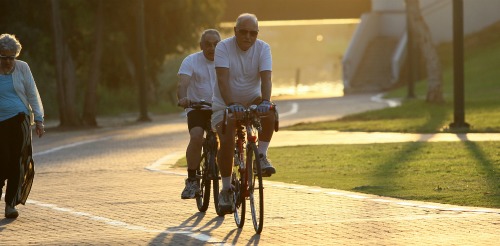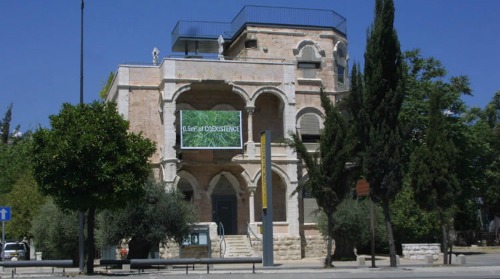There’s no shortage of fascinating tourist sites for the first time traveler to Israel. But what about on that next visit, when you’ve already done Jerusalem, Tel Aviv and Masada? Fortunately, we have just the TripTik for you: our top 10 “off-the-beaten-track” tourist attractions in Israel.
Tucked away on a lonely hill in the outskirts of Rehovot, the Ayalon Institute is often referred to as the “underground ammunition museum,” as it is 13 feet under a former kibbutz laundry facility and bakery.
The Institute was founded to clandestinely build bullets for the Hagana military forces during the years leading up to the War of Independence. To hide what the Jews were doing from the British, the factory was concealed underneath a “training institute” intended to prepare immigrants for kibbutz life.
Entrance to the factory was beneath the main drum of the laundry’s washer. 40,000 bullets a day were produced between 1945 and 1948. Tours are available in many languages.
Reservations required: 08-940-6552 or ayalon@shimur.org.il
2. Biking in Tel Aviv’s HaYarkon Park

HaYarkon Park is one of Tel Aviv’s loveliest stretches of urban green. It starts near the exhibition grounds and goes all the way to the beach. With its mostly flat terrain, plenty of trees and well-planned rights of way that easily skirt rush-hour traffic, the park is particularly popular with bikers.
Don’t have a bike of your own? Rent one at BikePlanet at the eastern end of the park. The ride to the water takes 30 to 40 minutes depending on how fast you’re pedaling, but don’t stop there – the path continues through the middle of the old Tel Aviv Port, past the city’s prime beaches and fancy hotels, all the way to Jaffa. A full round trip will take at least a couple of hours.
3. Lake Hula

You don’t have to be a bird lover to love Lake Hula in the northern Galilee. This beautiful and unique spot, located off Highway 90 on the road between Tiberias and Kiryat Shmona, is right on the great Syrian-Africa Rift and is a stopping point in the fall and winter for some 500 million birds (from 400 species) migrating from Europe to Africa and back.
Tens of thousands of birds, including cranes, storks, pelicans, cormorants and egrets, stay in the reserve year round. No cars are allowed near the lake, but you can either walk, or cycle. Bikes can be rented at the main entrance; a leisurely ride around the lake takes about two hours. For a less strenuous adventure, book a four-seat electric “golf cart.”
For a truly unforgettable experience go at dawn or sunset, when the birds are at their most active. Any time of the day will be beautiful, however, as flocks of cranes wheel lazily in vast circles above the lake.
4. Museum on the Seam

Think you’ve seen just about every museum Israel has to offer? Then check out the Museum on the Seam, a little-known gem that calls itself a “socio-political contemporary art museum that presents art as a language with no boundaries.”
The slogan is ironic, given that the museum is built right along the former pre-1967 “seam” between Israel and Jordan, just west of the Old City.
The Museum on the Seam aims to provoke: The current exhibition is called “Westend” and it asks whether there can be dialogue between the West and Islam — or only a clash of civilizations. The building was constructed in 1932 and served as an army outpost from 1948 to 1967.
Advance reservations recommended: 02-628-1278
5. The Palmach Museum

The Palmach Museum in Ramat Gan tells the story of a fictional group of young recruits in the years before Israel’s founding.
The Palmach was the elite fighting force of the Hagana, an underground military organization (you remember them from the tour earlier of the Ayalon Institute).
The museum has no displays or documents; instead you walk through a series of rooms populated with films, artifacts and full size “dioramas.” By the end of the 90-minute tour, you may cry as the characters you have gotten to know (played by professional actors) don’t all survive the War of Independence.
Presentations are in many languages, including Hebrew, English, Spanish, French and Russian.
Reservations required: 03-643-6393 or palmach_reservation@mod.gov.il
6. The Herzl Museum

The Herzl Museum in Jerusalem also has visitors walk through an interactive experience, in this case illuminating the life of Zionist visionary Theodor Herzl.
The story line is that Israeli actor Lior Michaeli is asked to play the part of Herzl in a movie. Michaeli’s process of learning more about Herzl in order to take on the role in the film propels visitors to move through the four rooms of the museum.
Each describes the changes Herzl went through, from his early years as a bourgeois European to his post-Dreyfus trial transformation into an international statesman and journalist who convinces his cohorts that “if you will it, it is not a dream.”
To book tickets and choose among five languages for the tour: http://www.herzl.org/English/
7. Tmol-Shilshom Bookstore and Café
Why are we including a restaurant on our off-the-beaten-track list? Jerusalem’s Tmol-Shilshom (“Those Were the Days,” the title of a Shai Agnon novel) is more than just a place to grab a bite to eat. It’s also a literary-culinary meeting point with regular lectures by Israeli and visiting authors, several well-stocked bookshelves for borrowing a quick read, and a gourmet, yet reasonably priced menu cleverly organized into sections such as “Introduction,” “Plot” and “Conclusion.”
An English-language creative writing workshop usually takes place in the fall. The place oozes ambience and is a funky place to fall in love with Israel all over again.
Reservations: 02-623-2758
8. The Sculpture Road
Whether you’re traveling by car or if you’re up for a hike, halfway between Jerusalem and Tel Aviv lies the Sculpture Road, an enjoyable day trip out of the city with a creative twist of art interspersed throughout.
The 10-kilometer (6.2-mile) route (Derech HaPesalim in Hebrew) is situated in the President’s Forest, dedicated to the memory of Israel’s first president, Dr. Chaim Weizmann.
In the 1990s, when artists from the former Soviet Union immigrated to Israel, a number of them were invited to line the road with environmentally friendly statues. Don’t miss the enormous statue honoring the space shuttle program.
The Sculpture Road begins along Route 44 off the Jerusalem-Tel Aviv Highway. Bring a picnic lunch and eat at one of the many benches and tables along the way.
9. Clore Garden of Science

Tucked in the center of Rehovot’s Weizmann Institute of Science, one of Israel’s most prestigious universities, is the Clore Garden of Science, an outdoor museum aimed at the kids but just as enjoyable for their parents.
The garden features 58 different exhibits demonstrating the laws of physics, solar energy and water power, all of them hands-on, set over 800 square meters (28,256 square feet) of green lawns.
There are wave machines and solar-powered fountains, plus “TrampoLuna,” which simulates a moonwalk where you feel only 1/6 of your normal weight.
Information: 08-934-4401 or Garden.Science@weizmann.ac.il
10. The prehistoric caves on Mount Carmel

Cavemen? In Israel? Truly one of the most off-the-beaten-track adventures in the Holy Land is a visit to the prehistoric caves on Mount Carmel, 15 minutes south of Haifa.
There are three caves in the Nahal Me’arot (“Valley of the Caves”) Nature Reserve, a national park where remains indicate that both Homo sapiens and Neanderthals lived here at one time, dating back almost 500,000 years.
You won’t find bones lying around anymore — the archeologists long ago snapped these up — but the guidebook will tell you about the 14 human-looking skeletons found in the Skhul cave, the second of the three.
There’s a circular trail through the valley and up the ridge that takes about two hours. To get into the caves requires climbing up a fairly steep ladder.
Information: 04-984-1750 (Parks Authority)
Fighting for Israel's truth
We cover what makes life in Israel so special — it's people. A non-profit organization, ISRAEL21c's team of journalists are committed to telling stories that humanize Israelis and show their positive impact on our world. You can bring these stories to life by making a donation of $6/month.





